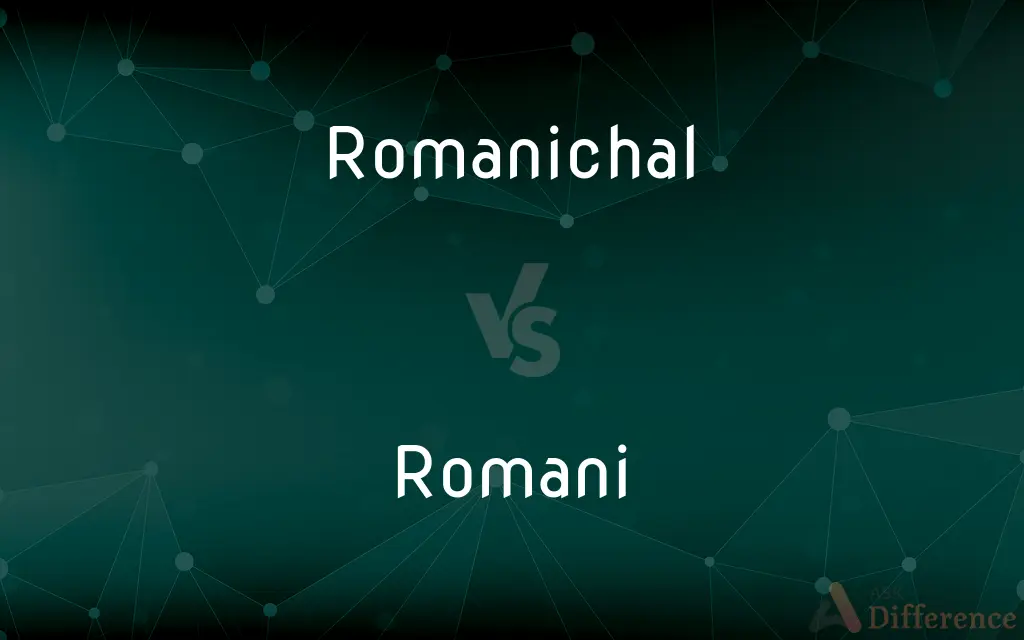Romanichal vs. Romani — What's the Difference?
By Tayyaba Rehman & Urooj Arif — Updated on April 2, 2024
Romanichal refers to a subgroup of the Romani people, primarily found in the UK, characterized by distinct cultural practices, while Romani encompasses a broader ethnic group with diverse subgroups across Europe and the Americas.

Difference Between Romanichal and Romani
Table of Contents
ADVERTISEMENT
Key Differences
Romanichal are a specific subgroup within the Romani people, originally descending from the Romani who entered the British Isles in the 16th century. They have developed their own unique cultural practices, language variants (Angloromani), and traditions distinct from other Romani groups. On the other hand, Romani refers to the wider ethnic group of people with their origins in northern India, who migrated to Europe around a thousand years ago. The Romani have since spread across the world, forming various subgroups with distinct languages, cultures, and identities.
The Romanichal in the UK and some parts of the United States have a specific dialect of Romani influenced by English, which reflects their long history within English-speaking countries. Whereas, the Romani people encompass a variety of dialects and languages depending on their geographic location, including Romani Chib, the traditional Romani language, which has several dialects across Europe and beyond.
In terms of culture, Romanichal traditions have been influenced significantly by their interaction with British society, leading to a blend of Romani and British cultural elements. This includes specific customs, occupational tendencies, and modes of living. The broader Romani culture, however, encompasses a wide range of traditions and customs that vary significantly between different Romani subgroups, reflecting the diverse histories and influences of each community.
Romanichal have faced similar challenges as other Romani groups, including discrimination, marginalization, and issues with social integration. However, the nature and context of these challenges can vary greatly. The broader Romani community faces a complex set of issues that reflect their diverse socioeconomic and cultural backgrounds, as well as the varying attitudes of the societies they live in.
Despite these differences, both Romanichal and Romani share a common heritage and face related challenges in terms of maintaining their cultural identity and combating prejudice. They both play a significant role in the rich tapestry of cultures within the countries they reside in, contributing to the cultural diversity and complexity of these societies.
ADVERTISEMENT
Comparison Chart
Geographic Origin
Primarily the UK and parts of the US
Originated in northern India, now dispersed globally
Language
Angloromani, a dialect influenced by English
Various, including Romani Chib with multiple dialects
Cultural Influence
Blend of Romani and British cultural elements
Diverse, reflecting the wide range of societies they inhabit
Social Challenges
Discrimination and marginalization within British society
Varied, depending on regional and national contexts
Identity
A distinct subgroup within the Romani people
Encompasses the broader ethnic group and its diverse subgroups
Compare with Definitions
Romanichal
A dialect that mixes Romani and English.
Romanichal individuals often speak Angloromani among themselves.
Romani
Spread across Europe, the Americas, and beyond.
Romani communities can be found from Spain to Brazil, each with unique traditions.
Romanichal
Notably found in the UK, with a significant population in the United States.
The Romanichal community in the UK has a long history dating back to the 16th century.
Romani
Face a complex set of social and political challenges globally.
Romani activists advocate for rights and recognition in multiple countries.
Romanichal
A distinct group within the Romani community, primarily located in the UK.
The Romanichal have a unique cultural identity in England.
Romani
A diverse ethnic group originating from northern India.
The Romani people have a rich cultural heritage with roots in India.
Romanichal
Unique traditions influenced by British society.
Romanichal weddings often incorporate both Romani and British customs.
Romani
Cultural customs vary widely among subgroups.
Romani music and dance forms are celebrated aspects of their cultural diversity.
Romanichal
Face discrimination and issues of marginalization.
Romanichal communities work towards greater social integration and understanding.
Romani
Speaks various dialects of Romani Chib.
Romani groups across Europe maintain their language with regional dialects.
Romanichal
Romanichal Travellers (UK: US: ; more commonly known as English Gypsies or English Travellers) are a Romani subgroup within the United Kingdom and other parts of the English-speaking world. There are an estimated 200,000 Romani in the United Kingdom; almost all live in England.
Romani
A member of a people that arrived in Europe in migrations from northern India around the 14th century, now also living in the Americas and Australia. Many Romani groups have preserved elements of their traditional culture, including an itinerant existence and the Romani language. Also called Roma.
Romani
The Indic language of the Romani.
Romani
Of or relating to the Romani or their language or culture.
Romani
Of or relating to the Gypsies or their language or culture;
Romani nomads
Romany folk songs
A Gypsy fortune-teller
Common Curiosities
Is Angloromani the same as Romani Chib?
No, Angloromani is a dialect influenced by English spoken by the Romanichal, while Romani Chib refers to the traditional language of the Romani people with several dialects.
How do Romanichal and other Romani groups maintain their culture?
Through language, traditions, and community events, both Romanichal and other Romani groups preserve and celebrate their heritage.
Who are the Romanichal?
The Romanichal are a subgroup of the Romani people, primarily residing in the UK, known for their unique cultural practices and dialect.
Can Romanichal be found outside the UK?
Yes, there are Romanichal communities in the United States and other parts of the world, though they are most notably associated with the UK.
What are common misconceptions about the Romani and Romanichal?
Common misconceptions include stereotypes about lifestyle, occupation, and legal status, often stemming from historical prejudice.
Are there any similarities between Romanichal and other Romani subgroups?
Despite cultural differences, they share a common ancestry, face similar social challenges, and have a deep respect for family and community ties.
What role do language and music play in Romani culture?
Language and music are central to Romani identity, serving as expressions of history, resilience, and cultural diversity.
How have Romanichal adapted their traditions in the modern world?
Romanichal have blended their traditional practices with elements of British culture, adapting while maintaining their unique identity.
How do educational levels vary within the Romani and Romanichal communities?
Educational attainment varies widely, with efforts ongoing to improve access to education for Romani and Romanichal children.
What are the key challenges facing Romani people today?
Challenges include discrimination, marginalization, and securing rights to education, health care, and housing.
What distinguishes Romani people?
Romani people are a diverse ethnic group with origins in northern India, characterized by their spread across the globe and varied cultural traditions.
How do Romanichal and Romani communities contribute to society?
Through cultural enrichment, including music, art, and craftsmanship, and by advocating for social and political rights.
Is there a political representation for Romani and Romanichal peoples?
Yes, there are activists and organizations that represent their interests at both national and international levels.
What initiatives are in place to improve Romani and Romanichal peoples' lives?
Initiatives include cultural preservation projects, legal advocacy for rights and recognition, and programs aimed at improving education and employment opportunities.
How do the Romanichal view their identity within the larger Romani community?
Many Romanichal view their identity as both distinct and part of the broader Romani heritage, valuing their unique traditions and shared ancestry.
Share Your Discovery

Previous Comparison
Procedure vs. Process
Next Comparison
Router vs. FirewallAuthor Spotlight
Written by
Tayyaba RehmanTayyaba Rehman is a distinguished writer, currently serving as a primary contributor to askdifference.com. As a researcher in semantics and etymology, Tayyaba's passion for the complexity of languages and their distinctions has found a perfect home on the platform. Tayyaba delves into the intricacies of language, distinguishing between commonly confused words and phrases, thereby providing clarity for readers worldwide.
Co-written by
Urooj ArifUrooj is a skilled content writer at Ask Difference, known for her exceptional ability to simplify complex topics into engaging and informative content. With a passion for research and a flair for clear, concise writing, she consistently delivers articles that resonate with our diverse audience.
















































